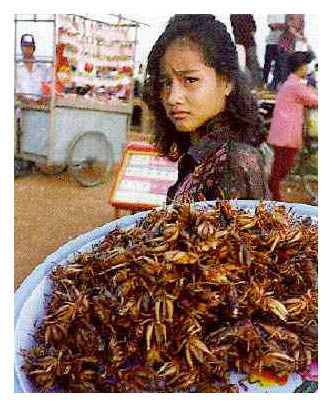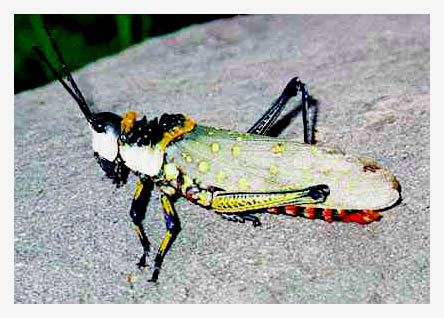Interactions with Our Insect
Friends
 | May is locust season!
Every spring, kids come around with baskets of these tasty fried locusts. The best way to eat them is to snap off their lower legs (otherwise they scratch up your throat something awful), and sautee them again so they're piping hot! |
1. We have noticed a wandering trail across the top of a wall in the kitchen,
visible in white against a background of light grime. This trail is used
by tiny ants,
whose feet have worn through to the paint. Each time ants going opposite
directions encounter each other on this trail, they pause for a brief conference.
2. Last week I emptied out my desk drawers, after finding piles of sawdust
mixed in with my files and computer disks there. Termites had been eating
the structural members of the drawers. Every day I spray them with Shelltox,
and fumigate the desk, shutting the drawers with the fumes inside. I find
the dead bodies of the termites lying in there. They are surprisingly big--nearly
a centimeter long and equipped with mandibles which are still full of yellow
sawdust even as they lie in death.
Today I carried the drawers through the art shop downstairs and out to the
sidewalk. I squatted on the curb and chipped out the soft wood with a screwdriver.
Parts that appeared nearly solid were revealed to be riddled with tunnels
through lacelike remains. The termites like to cruise just below the surface,
leaving a paper-thin wall of wood on the exposed surface. I caught a couple
of them still alive, incredibly, burrowed deep into the wood.
The severed head of a termite can survive for more than five minutes, mandibles
chewing furiously on air.

Spotted at Phnom Chisor, Cambodia
3. I've run across a couple of oddities in the past week. The first one
was racing along the floor behind my bed. I thought it was a roach, and
I drew the Shelltox, but something in the way it moved gave me pause. Actually,
that's fair, because it already had paws: big front legs with club-like
serrated scrapers for hands. It had a huge head, shaped like a lobster's
head, and it moved like a mammal, in a nervous twitchy way. I trapped it
in a jar. The next morning, it was still. "Oh no, Lumbo's dead,"
cried Poppy (who had surrounded the jar with plastic animals as night-time
friends for the beast). But a breath of fresh air soon got Lumbo back into
action, and he was scraping valiantly at the plastic. We brought him outside to a patch
of weeds and upended the jar. Lumbo dove like a submarine: front end down,
rear end up, and sinking fast.
4. The second oddity made itself known by interfering with my foot's downward
descent, yesterday in my room at the fabulous Crystal Motel on Ochateal
Beach. Hmm, I said to myself, I didn't leave anything--like a hedgehog for
example--on the floor there. I better look and see what it is. It had a
round body, and five and a half long legs, each with a spur-like extension.
On the front was a small round head with one eye on either side of a long,
tapered, downward-curving snout. Halfway down the snout, two little branches
came out, made a right angle and ended in a tiny, quivering bulb. It stood
stock-still. The animal looked like Snuffeluphagus, Big Bird's oft-invisible
friend. It had a mournful expression--like "I know I'm an oddity, but
I can't help it. Please, just pretend I'm invisible." So I smashed
it. No, actually I trapped it in a glass. As I slipped the paper under the
glass, it daintily raised each leg in turn, until it was standing on the
paper. I put it out in a potted plant, but it toppled over onto its back,
and froze in panic. Oh well, you can't do everything for them.
Bonus for looking this far down the page
Not more that 20 minutes after I wrote about the oddities in 3 and 4, above,
a group of people walked up to the table where I was sitting, and asked
what I was typing, there on the beach in Sihanoukville. It turned out that
they were all from the International Rice Research Institute, and one of
them, Gary, was an entomologist. Right place, right time.
He read the above, and pronounced number 3 to be a predacious
diving beetle, which breathes through spiracles on its back, and can
trap air beneath its shell in order to breathe while underwater. Some of
them are big enough to catch and eat fish. Number 4 is apparently some type
of weevil.
 go to top of this page
go to top of this page
go to new site entrance
e-mail me your comments



 go to top of this page
go to top of this page